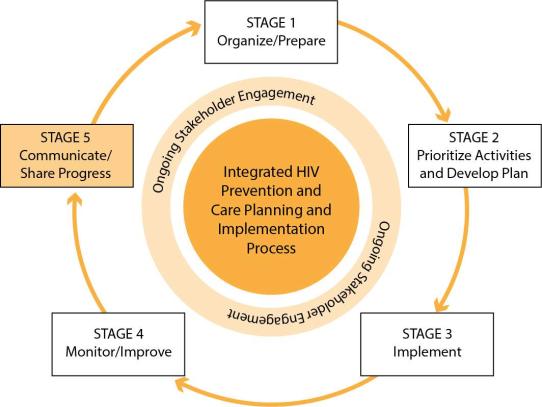
Stage five builds on previous activities to share information about Integrated Plan implementation and progress with key stakeholders, and communicate with broader audiences as appropriate. In this stage, jurisdictions have the opportunity to synthesize data and present information in the most appropriate format based on the needs of the audience. Jurisdictions may develop infographics, other visuals, and briefs tailored to communicate key messages and progress to diverse groups or partners.
While Integrated Plans include a great deal of information needed to guide a jurisdictions' ongoing activities, they often contain more information than stakeholders may require in a presentation. Consider creating a succinct, visual summary to synthesize Integrated Plan activities and effectively communicate progress.
It is important to update and share Integrated Plan implementation progress regularly to planning bodies and other stakeholders. Communication on plan progress includes highlighting successes, identifying challenges in implementation, and recommending modifications to plan activities.
Promising Practices and Tips
- Create a progress report or activity dashboard that is updated and shared regularly according to an established schedule.
- Distill the Integrated Plan and its activities into a succinct, visual or snapshot to promote or communicate progress.
- Tailor communications to the needs of the intended audience.
Tools and Resources
- Arizona 2022-2026 HIV/STI/Hep C Integrated Plan: Goals, Objectives, and Strategies. Arizona created a public, condensed version of their 2022-2026 HIV/STI/Hep C Integrated Plan, highlighting the goals, objectives, and strategies. It also includes a list of strategies called “If we could, we would” strategies. These are strategies that were identified during the planning process that fall outside of the scope of Arizona’s HIV, STI, and hep C programs and are included to encourage external partners to incorporate these strategies into their own efforts.
- Wisconsin Integrated HIV Prevention & Care Plan 2022 - 2026 Overview. This document, developed by the Wisconsin Department of Health Services, distills the Wisconsin Integrated HIV Prevention and Care Plan into a 12-page summary, outlining the Plan goals, objectives, and suggested activities.
- Wisconsin Integrated HIV Plan 2017 — 2021: 2022 Progress Report. The document, developed by the Wisconsin Department of Health Services, describes the progress made for the objectives and key elements of the Integrated HIV Prevention and Care Plan, as well as new actions and activities since prior reporting.
- Wisconsin Integrated HIV Plan 2017-2021: 2019 Progress Report (July 2019). This progress report, developed by the Wisconsin Department of Health Services, provides a brief update on the actions that Wisconsin has taken toward meeting the goals in their Integrated Plan. The report is framed around the 10 Key Elements, or objectives, framing Wisconsin’s Integrated Plan and how the state’s HIV program and partners are addressing the HIV epidemic in their state.
- Overview: Wisconsin Integrated HIV Prevention and Care Plan (March 2019). This summary document, developed by the Wisconsin Department of Health Services, distills the Wisconsin Integrated HIV Prevention and Care Plan into a ten-page snapshot, primarily used by local health departments and community-based organizations to identify strategies and data that support their grant writing.
- Wisconsin Integrated HIV Prevention and Care Plan At a Glance (March 2019). This one-page snapshot of the Wisconsin Integrated HIV Prevention and Care Plan summarizes the state’s Integrated Plan into a synthesized and digestible document. Such summaries are helpful for media releases and can serve as handouts at public presentations on the HIV Integrated Plan.
- Ohio HIV Prevention and Care Integrated Plan Steering Committee Newsletter (October 2019). This sample newsletter, developed by the Ohio Prevention and Care Integrated Plan Steering Committee, updates stakeholders about progress on Integrated Plan activities.
- PrEP Navigation Reporting Visual (July 2018). This infographic report offers easy-to-read visuals about PrEP navigation services. The Arizona Department of Health Services and the Maricopa County Ryan White HIV/AIDS Part A Program developed this one-pager to provide updates to the HIV Statewide Advisory Group and Community Health Planning & Strategies Committee.
- Integrated HIV Prevention and Care Plan Objectives and Activities Progress Visual (March 2018). This visual, developed by the Washington State Department of Health, illustrates the progress on the objectives and related activities developed to achieve the goals of the Integrated HIV Prevention and Care Plan. The horizontal pink bars indicate the amount of progress made on the particular activity.